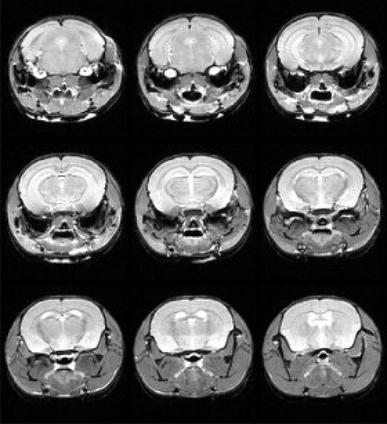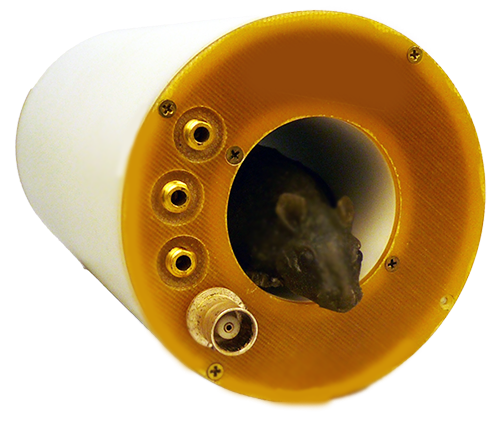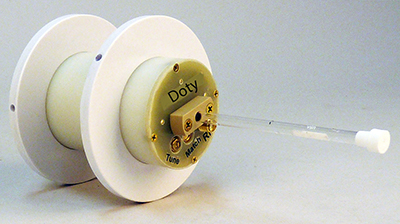Small Animal RF Coils
MRI volume coils with best sensitivity, homogeneity, and convenience.
Easy tuning
Mouse Coils – Rat Coils – Rabbit Coils – Primate Head Coils
A unique symmetrizing circuit ensures the coil is easily tuned and matched to the full range of samples with negligible loss in efficiency, channel separation, or symmetry. The tuning range is much better than with conventional birdcages and tuning methods.
Robust Design
Versatile, Robust Design
In Doty Imaging Modules, the rf Litz or Litzcage coils are enclosed in the rf shield and packaged in an integrated aesthetic cover. Coil dimensions are customized to your specifications.
Exceptional Sensitivity
The linear Litz or CP (circular polarization) Quadrature Litzcage coils have SNR 10-15% higher than with conventional linear or quadrature birdcages of similar dimensions – and often much better. The B1 homogeneity is 10-30% better and the coils have improved B0 homogeneity. Simple-tune Litz coils can be easily double-tuned.
Doty RF Volume Coils
You wouldn’t consider buying something like a computer or spectrum analyzer without reviewing and comparing detailed specifications. You owe it to yourself to apply the same critical standards when purchasing an rf coil. With rf coils, the most important criteria usually are S/N, B1 homogeneity, and reliability. For S/N, simply check the 90° pulse spec. Regardless of whether it’s single or double resonance, shielded or unshielded, linear or circular polarization, short or long, surface or volume, one simple relationship always holds for a given voxel size and other conditions:
where τ90 is the 90° pulse length (we specify for a hard pulse) and P is the transmitter power. Many of the smaller coils listed in the tables have S/N better by factors of 1.5 to 3 than published birdcages of similar size and tuning. Our 1H Litzcages have truly extraordinary robustnesss, ease-of-use with widely differing samples, homogeneity, and S/N.
Does your τ90 drop by less than a factor of two (at constant P ) when your sample diameter drops by a factor of 2? Do you have difficulty matching and tuning with certain samples? Are you tired of tweaking numerous adjustments to try to get acceptable B1 homogeneity with your samples? If you answered yes to any of the above, you should inquire whether a Doty Litz or Litzcage coil could improve your results.
With all the improvements, customers are often surprised that there is usually a substantial cost advantage in choosing Doty coils.
MRI 7 T Rat Spinal Cord Studies: In vivo in a Doty
56 x 56 mm 1H volume coil and ex vivo in a 1H MRI Doty slotted resonator for a 5 mm sample tube.
A customer contacted us with a request to build custom coils for their studies on rat spinal cord, both in vivo and ex vivo, motivated by performance issues related to RF homogeneity and shielding exhibited in current OEM coils. A quadrature volume coil with 56 mm ID was constructed for the in vivo imaging (on awake or mildly anesthetized rats), and was utilized at the study onset.
The volume coil’s excellent sensitivity made it possible to generate high resolution DTI images of an injured spinal cord in vivo, with weekly scanning to monitor treatment progress.

When treatments ended, it was desired to image an excised cord, with smaller FOV to visualize more specific spinal tracts. High S/N and excellent B1 homogeneity were top priorities. To meet this goal, a Doty slotted resonator (one-turn saddle coil) was used to construct a small coil for the spinal cord contained in a 5 mm NMR tube.

Both coils were tuned to 1H, for use with a 7 T small animal imaging system. Images were processed with DSI Studio software (Fang-Cheng (Frank) Yeh, Dept of Neurological Surgery, University of Pittsburgh).
From Laboratory of Dr. Prodip Bose; Malcom Randall VA Medical Center, Gainesville, FL.
Download a preprint of “RF Coil Technology for Small-Animal MRI”, by F. David Doty, George Entzminger, Jatin Kulkarni, Kranti Pamarthy and John P. Staab, published in [NMR Biomed. 2007; 20: 304-325, published online in Wiley Interscience, at http://www.interscience.wiley.com, DOI: 10.1002/nbm.1149].
Images
Mouse Brain Images

This T2 spin-echo experiment on a live mouse brain using a 2 cm linear Litz coil in a 4.7 T horizontal magnet demonstrated substantially better B1 homogeneity and better S/N than a quadrature birdcage of similar dimensions. The Litz coil easily tuned and matched to any load in less than a minute.
Images courtesy of Dr. Joel R. Garbow, Washington University, St. Louis, MO.





